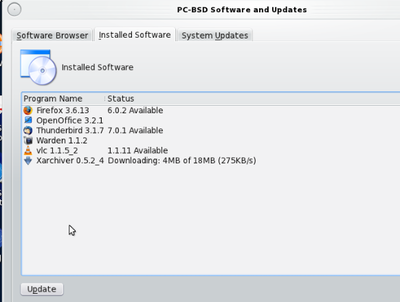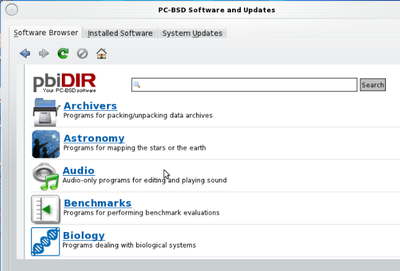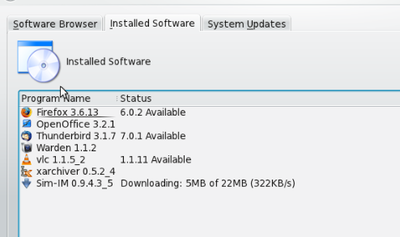COMP 3000 2011 Report II:PC-BSD
Part II
Software Packaging
This distribution is PC-BSD. Linux package formats are the different file formats used to package software for various Linux distributions. Here in PC-BSD, it mainly uses Binary Packaging format -- pbi<ref>http://en.wikipedia.org/wiki/List_of_software_package_management_systems#PC-BSD</ref>. This distribution uses lots of graphic utilities<ref>http://www.pcbsd.org/about/pc-bsd-project/utilities</ref> to provide front-end to useful FreeBSD features, such as Software Management Utility, Virtual Environment Utility, Backup Utility, Ports Jails Utility and so on.
In the distribution, it use we can use pkg management utilities<ref>http://wiki.pcbsd.org/index.php/Ports_Jail</ref> to manage packages.In command line, it will use "pkg_info" to get a list of installed packagers, "pkg_add" to add packages, and "pkg_delete" to remove packages. In PC-BSD 9.0, it will use PBI manager<ref>http://wiki.pcbsd.org/index.php/PBI_Manager</ref>, which will use "pbi_info", "pbi_add", "pbi_delete" instead. The PC-BSD repository<ref>http://en.wikipedia.org/wiki/PC-BSD#Package_management</ref> is http://www.pbidir.com/. The software catalog can found from there.
Because PC-BSD provides Graphic tools for desktop user, there is utility Software Management to do some thing like pkg management. Here it is:
There is utility called Software Management (in PC-BSD version 8.2), which can get a list of installed packages, except for system packages installed during installation of this distribution, like this picture:
PC-BSD is aim to give user easy used install/remove package experience like Windows or Mac OS. The applications are installed from a simple downloaded file with graphic prompts. Software Management is also a very useful utility to find desired software and install them by clicking the link. Remove is also a simply mouse click operation. There is a website browser in the Software Management and search engine for keyword search and different catalogs for selections.
After made decision, it can downloaded the software by clicking the download link. And it will automatically download and install the packages/software.
There is also a remove button under "Installed Software" menu. Simply choose the package needed to remove, and click remove.
The software catalog for this distribution can be found in the Software Browser of Software Management. There are many selections: Archives, Astronomy, Audio, Benchmarks, Biology, CAD, Communications, Databases, Desktop Utilities, Development, E-Mail, Editors, Educational, Emulators, File Transfer & Utilities, Finance, Games, Graphics, IRC, Japanese, Java, Languages, Math, Miscellaneous, Multimedia, Network-IM, Network-Management, Network-P2P, Network-Utilities, News, Non-Port, Polish, Ports-Management, Print, Science, Security, Shells, System Utilities, Text Processing, The Warden-Inmates, Web, X11, X11-File Managers and X11-Window Managers.
There is too many packages to choose, part of catalog information can be seen from the previous picture.
Major package versions
Report on the version numbers and upstream source (URL of original source) for some of the major software packages included in your distribution as part of the standard install:
Linux Kernel or other kernel libc X.org or other GUI foundation Major GUI toolkits (Gtk+, Qt, Motif, etc.) shell (bash, csh, etc.) utilities (ls, ps, busybox) software packaging (rpm, dpkg, etc.) Web browser email other packages that are key to system usage
CBold texthoose at least 10 packages that fit into this list (you don't need to cover every category) and report the following:
What is the vintage of the included package? How old is it, and how far is it behind the latest stable release for this package? How heavily has the package been modified by the distribution authors? (You'll need to figure out how to determine this.) Why do you think this particular package was chosen for this distribution's standard install? You may speculate, but please make an argument informed by relevant facts.
// qliu1
X.org:
version number: 11.0, release 7.5 (Oct 26, 2009) <ref>http://www.x.org/wiki/Releases/7.5</ref>. latest version: X11R7.6 on Dec 20, 2010.<ref>http://www.x.org/wiki/Releases/7.6</ref>
Qt
version number: 4.7.1
latest version:
modification:
KDE
version number: 4.5.5
latest version:
modification:
bash
version number: 4.1.9
latest version:
modification:
pth
version number: 2.0.7
latest version:
modification:
ruby
version number: 1.8.7.302
latest version:
modification:
Konqueror(web browser)
version number: 4.5.5 using KDE Development Environment
latest version:
modification:
KMail
version number: 1.13.5, using KDE 4.5.5
latest version:
modification:
// todetoyi
RPM
Version Number : 3.0.6
URL Source : www.rpm.org
Gwenview
Version number : 1.2.92(2005-08-21) Image viewer for KDE
ARK
Initialization
Here describe how your distribution initializes itself. Specifically, give an outline of what programs are executed and in what order. Also document how you discovered this information. You do not need to include every program; however, you should be able to identify at least five major programs that are run.
Note that you should provide an explanation for how all of the major processes end up running on a fully initialized system.
Reference
<references/>


